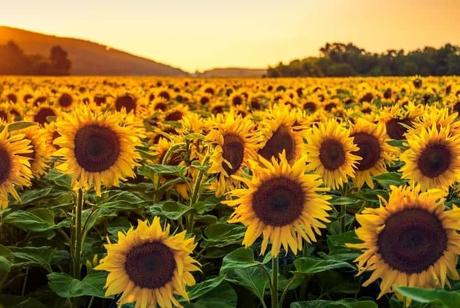With almost 70 different species, you’re left with unlimited options when it comes to choosing a sunflower. Bearing flowers annually, sunflowers are often grown for their stunning appeal and their multiple functionalities. For the uninitiated, sunflowers are often extracted for their oil as they are an edible plant.
Exceptionally hardy, these flowers are also quite easy to maintain. An average variety of sunflower can grow between three to 18 feet, depending on the variety. The flower beads usually measure around two to six inches in width. While yellow is the most popular color, other color options include orange, red, and even burgundy. Sunflowers are an ideal houseplant, though you can always pot them in your garden.
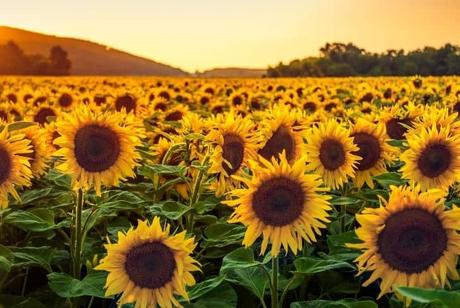
If you’re looking to add a perfect dash of sunshine to your backyard or homes without having to plant sunflowers, there are plenty of options out there! While this may seem surprising to many, there are multiple look-alikes of the average sunflower.
These flowers usually belong to the Asteraceae or the daisy family. But what exactly are flowers and how do you find them? Well, that is exactly what we are going to discuss in the course of this article.
13 Different Flowers That Look Like Sunflowers
1. Black-Eyed Susan
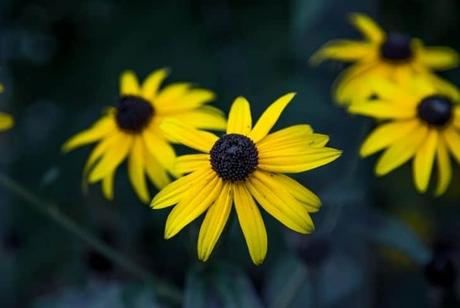
When it comes to Sunflower look-alikes, you will find plenty of flowers from the Asteraceae family making it to our list. One of the top contenders would be the Black-Eyed Susan that is also widely popular as the Gloriosa Daisy.
These plants boast a stunning yellow and orangish flowers with a dark brown area in the middle. Widely found in the wilderness they add just the right color to your regular grasslands. Given their simple and hassle-free maintenance options, the Black-Eyed Susan is also a top option among several homeowners.
As a potted plant, they are found in different variants like the Indian Summer and the Cherokee Sunset. Another top variant would be the Autumn Colour.
In the US, these flowers thrive well in moderately hardy zones ranging from three to nine. In certain areas, they are also grown annually during the winters. Overall, Susan grows fast and it blooms in the complete or partial sun.
If you plan to grow them at home, it is best to stick to a few guidelines. One of the first things you need to check is the temperature of the soil. These plants germinate better when the soil temperature has met or exceeded 70 degrees F. In certain parts of North America, it is recommended to plant the seeds between March and May.
You will then find them blooming between June and September. Germination usually takes a month or 40 days. However, this too will vary depending on the specie.
While planting the seeds, make sure the soil is nutritious and well-drained. It should be moist and not soggy at any instance. Since these flowers are similar to Sun Flowers, they enjoy plenty of sunlight. That is why, it is recommended to grow them in full sun, although you can also try partial shade.
While sowing the seeds, make sure they are loosely covered by the soil. While the plant can withstand difficult soil conditions, it is recommended to keep the soil fertile.
Upon maturing, Black-Eyed Susan can assume a height between one and three feet and a width of 10 to 20 inches. That is one of the many reasons why you need to plant the seeds right next to each other. This will create a perfect border once the flowers finally bloom.
2. Gerbera Daisy
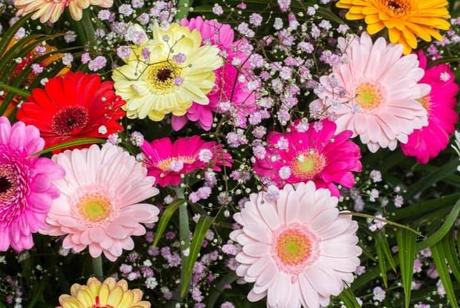
If you are planning to add a perfect tinge of colors to your yard without having to invest in Sun Flowers, the Gerbera Daisy might be a great option. With a lush, dark green foliage, these flowers have leaves assuming a width of 12 inches or more.
Unlike many other sunflower look-alikes, they are known for their fuzzy leaves. The stems of these plants are stout usually ranging between six to eight inches. Upon maturing, they can produce three-inch flowers in different colors like red, magenta, purple, orange, yellow, and even salmon. In certain instances, they may even be bi-colored.
If you are planning to grow them at home, make sure the plants get complete sun and a fully fertilized soil. They thrive best in US hardiness zones ranging from eight to eleven.
As with any other Sunflower lookalike, you need to water it frequently for the best results. Also, snip the withered flowers once in a while. This will boost flowering, especially during the winter months.
3. False Sunflowers
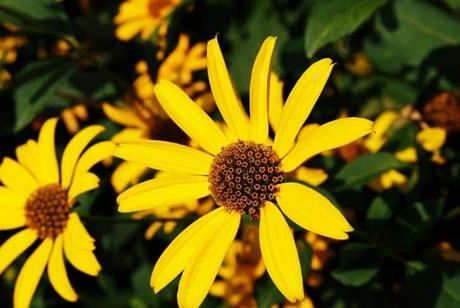
Perfectly named, these plants are a group of perennials belonging to the same Asteraceae family as the Black-Eyed Susan. Like sunflowers, they too are known for their bright yellow hues and long leaves. Upon maturing, they make just the perfect border in your wildflower garden. As with the Black-Eyed Susan, the False Sunflowers too are easy to grow and care for.
In the US, they thrive best in hardy soils ranging from four to nine. False sunflowers can tolerate high heat and they usually need plenty of sunlight to assume full growth. Unlike many other flowers, they are also susceptible to drought and poor soil conditions. Common variants include the Ballerinas and the Summer Suns.
If you are planning to grow them at home, it is recommended to follow some simple guidelines. First, you should always pluck the flowers once bloomed to avoid re-seeding and to ensure more blooms. However, this may not be as necessary if you are growing it in a completely natural environment.
Care and maintenance are absolutely minimal, so much so, that you can forget about them post-planting. However, it is recommended to deadhead to promote blooms.
4. Coneflowers
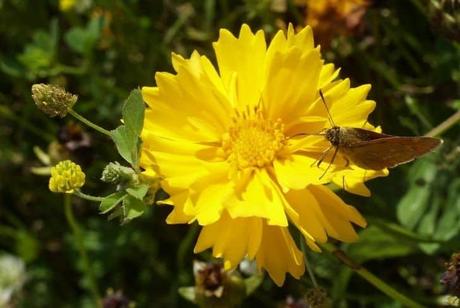
Yet another member from the Asteraceae family, Coneflowers are both easy to grow and care for. Available in a wide range of colors, they bear multiple similarities with the regular sunflower. Common variants include yellow, pink, fuchsia, occur, red, magenta, purple, and even orange. In some rare instances, you might find Coneflowers in white variants. Their centers are rich in nectar and therefore attract plenty of bees and butterflies.
Ideally, Coneflowers thrive best in a properly drained soil and require significantly less water when compared to other perennials. In terms of soil hardiness, zones between four to nine work best for them. Coneflowers are also popular as the Harvest Moon and Sunrise for their stunning hues.
If you are planting them at home, make sure you choose a location where they get full sun for at least six to eight hours at a stretch. If you are living in a warmer zone, eight or higher, consider providing one to three hours of afternoon shade. This will help the flower thrive better and prevent it from fading.
Coneflowers usually grow in clumps and that is why they won’t manage to spread far and wide like other perennials. Older variants are likely to self-seed if you keep the blooms in a proper position. This will also ensure that you get plenty of plants.
Ideally, you should plant these flowers during the Spring months. This will ensure that it doesn’t experience any danger from the frost. Again, you may also want to plant it during the early months of fall. Just ensure that they get enough time (at least six to seven weeks) for establishing their roots before the potential frost, else they may not bloom the following spring.
5. Bush Daisy
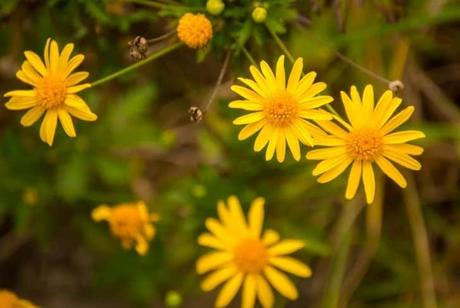
These are yet another common perennial resembling tiny Sunflowers. Alternatively known as the Golden Daisy or the African Daisy, these are but tender shrubs that bloom with pretty yellow flowers. As with sunflowers they have a black seedy center that tends to attract plenty of pollinators and birds.
These flowers are not known for closing during the evenings or the night. They also bloom throughout the year. In the US, Bush Daisy will grow in hardy zones ranging from nine to 15. They require full sun and nutritious, moisture-laden soil. If you are a gardener, you might want to grow them near your hedge or as a border in massive patio pots.
6. Tickseed
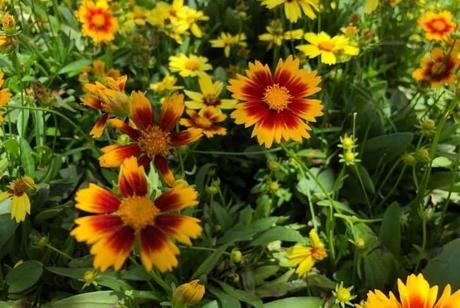
Abundantly found in the North American regions, these are yet another pretty perennial. They can grow at a height of two to four feet and are a great choice to border your garden or walkway. Belonging to the Asteraceae family, these flowers have wide and heavily designed petals. You will find them in shades of yellow, red, or multicolored variants.
Also known as the Pot gold, these plants thrive best when they receive full soil and a moisture-laden soil. In the US, they are abundantly found in hardiness zones of four to seven. For the best results, you should water the plant regularly.
7. Chrysanthemum
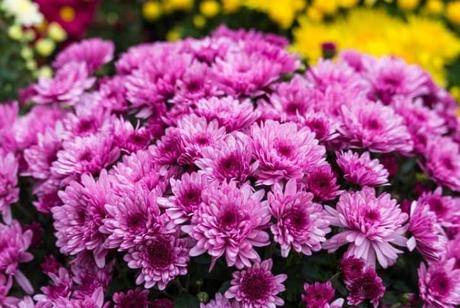
Known to be related to the Sunflower family, these vibrant flowers evoke the perfect image of Autumn. You should ideally plant them in Spring and upon blooming they can produce flowers ranging from one to three feet in height. Common colors include red, orange, salmon, white, and magenta.
While growing them at home, make sure the ‘mums’ receive plenty of shade. The soil should have ample moisture and you should water it regularly for best results. In the US, these plants are widely found in hardiness zones ranging from four to nine.
8. Yellow Daisy
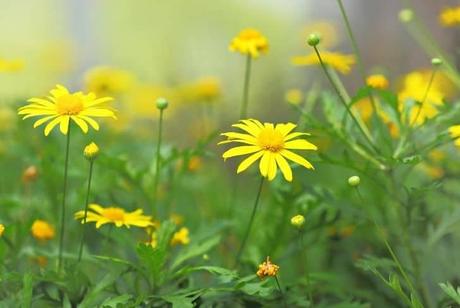
Yellow daisies start blooming in June and they continue bearing flowers throughout their entire summer. Their flowers resemble sunflowers, only the tinier variants. The stems of these plants are erect and the disk (usually present in the middle of the flower) is best known for its yellowish-green hue. As with most sunflower look-alikes, Yellow Daisies require moisture-laden soil with complete sunlight.
9. Diantus Carophyllus
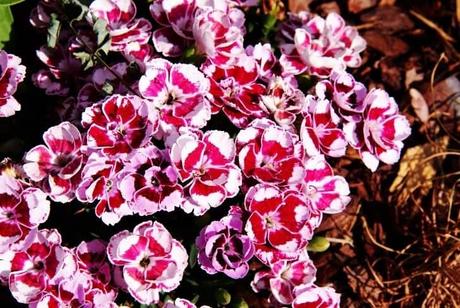
Alternatively known as Carnations, these flowers resemble sunflowers with their thin petals and large central disk. Unlike sunflowers, however, their disks are bright yellow and their colors range from red to orange. If you are planning to plant them at home, make sure the plant gets complete sun and partial shade during the afternoons. It thrives best in US hardiness zones ranging from three to ten.
10. Zinnia

While Zinnias may not exactly resemble Sunflowers, they do have some striking similarities. First are their petals that are thin and second is the color which is just as gorgeously yellow as the sunflowers. While planting these flowers, make sure they get plenty of sun in well-drained soil. These plants thrive well in hardiness zones ranging from three to ten.
11. Daisy
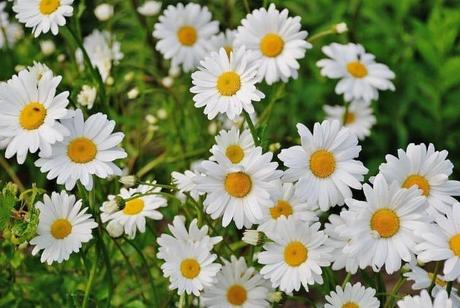
Unlike the Gerberas, daisies are only available in white and yellow. They are known for their leafless stems and dainty appeal. To grow daisies, make sure you live in US hardiness zone three to nine. Also, provide plenty of natural sunlight to plant and water it regularly.
12. Coreopsis
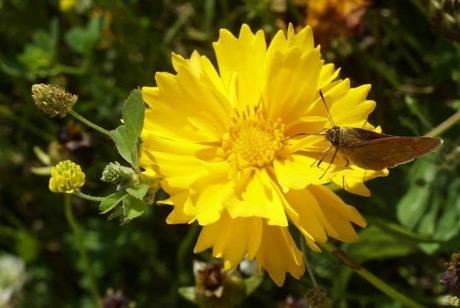
Coreopsis is a spectacular plant with yellow, salmon, and orangish flowers. They are almost similar to daisies and can thrive in all soil conditions. Ideal hardiness zone ranges from three to nine, and as with most other sunflower lookalikes they need full sun and loamy soil.
13. Transvaal Daisies
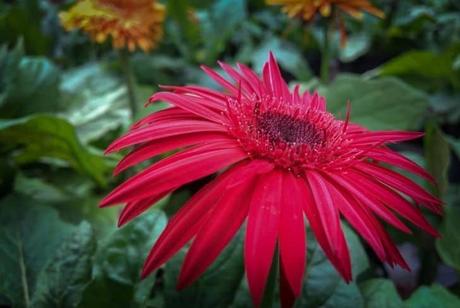
Transvaal Daisies are known for their notched leaves and bright flowers. Usually, these flowers can assume a height of 10 to 18 inches depending on the type. While the flowers are usually single, they may be double or semi-double in some instances. The colors range from pink, yellow, and red.
Well, now that you have a clear idea about the best sunflower lookalikes, wait no further, pick your favorite and brighten your backyard or patio like you always wanted to!
References:
Bush Daisy
Transvaal Daisies
